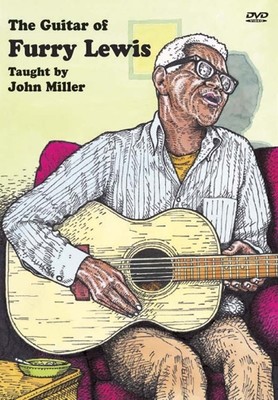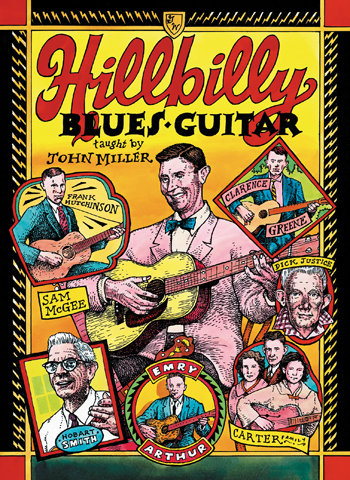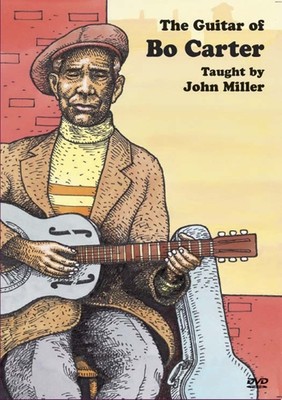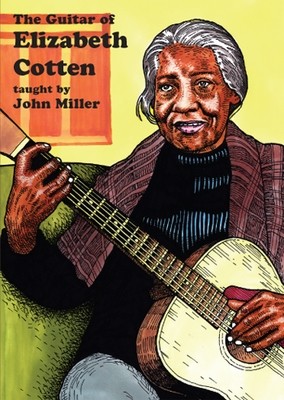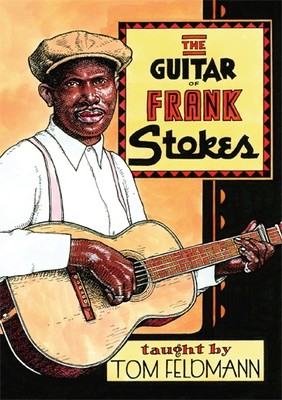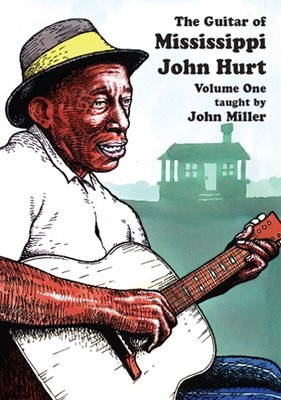
Hillbilly Blues Guitar - taught by John Miller
As the Country Blues began to be recorded, in the mid-1920s, it soon became apparent that the music was being played and appreciated not only by African-American musicians and audiences, but by white musicians and audiences as well. Many of these white musicians played with and learned from black musicians, for even in the Jim Crow Era there was always a good deal of musical interaction and exchange. So it is that the term "Hillbilly Blues" can be used to describe the music made by white musicians of that era in the Country Blues style.
Included on this DVD are songs from Clarence Greene, known mostly as a fiddler, but an ace guitarist, Dick Justice, who in his one day in the recording studio waxed ten masterful performances, Frank Hutchison who excelled at lap slide, harmonica on a rack and conventional blues picking, Sam McGee, a banjo and guitar master who went on to star on the Grand Ole Opry, Hobart Smith, a musical powerhouse, Maybelle Carter, a rocksteady and beautifully lyrical player who may have been the most influential of the bunch and Emry Arthur, a soulful singer and player who recorded one of the earliest versions of Man Of Constant Sorrow.
The songs selected for inclusion on the DVD have been chosen to introduce you to a variety of different keys and playing positions, as well as a host of different right hand techniques.
A PDF included on the DVD offers not only detailed transcriptions of the songs, but the songs' lyrics, too. All of the original performances by the musicians are included on the DVD as bonus tracks, both as references and for your listening enjoyment.
Titles include: CLARENCE GREENE Johnson City Blues DICK JUSTICE Brown Skin Blues FRANK HUTCHISON Cumberland Gap SAM McGEE Franklin Blues HOBART SMITH Graveyard Blues CARTER FAMILY The Cannon Ball EMRY ARTHUR Reuben, Oh Reuben
90 minutes - Level 2/3 - Detailed tab/music PDF file on the DVD
Review: The Black South didn't get all the best Depression-era licks. White Appalachia vented their misery over likewise inspirational creativity, as Hillbilly Blues Guitar instructively demonstrates. This how-to DVD pulsates with all sorts of moves: from thumb-thwacked leads and dash-away strums to more types of runs than a turkey through the corn. John Miller thoroughly breaks down, then reassembles, vintage songs so durable and enticing that everyone from John Fahey to the Old Crow Medicine Show has recycled them. They're the stuff of legend, from legends as historic as inductees in The Country Music Hall of Fame, includes on the super-famous Anthology Of American Folk Music, and recordees at the "Bristol Sessions," the great hillbilly roundup of 1927 and 1928. Albeit impressive, the lickety-split whoosh of Frank Hutchison's "Cumberland Gap" - a crown jewel in the repertoire of old-time mountain music - is still no match for the flying fingered finale of Sam McGee's "Franklin Blues" which leaves the strings breathless. Ol' nine fingered Emry Arthur tried to keep pace by adapting the banjo hanger "Reuben, Oh Reuben" to a banging guitar, while Clarence Greene, Dick Justice, and Hobart Smith ran the blues from Johnson City to the graveyard. A graceful locomotive, "Cannon Ball Blues," was preferred by The Carter Family. All these rhythmically driven guitars just beg to ring out in some lonesome hollow. – Dennis Rozanski/Blues Rag
Review: John Miller is perhaps the finest of Stefan Grossman's hugely talented batch of instructors. As gifted a player as any among them, his teaching within the constraints of time - assembling a number of songs on a single DVD - is systematically presented, well organized, and well explained. The beauty of John Miller's presentation here as on other DVD's he's put together, is that he always honours the lyrics which go with the playing of the songs. If not always with the split screen version, he does so in the initial performances he plays. This is very helpful to see just how seamlessly he phrases the lyrics to go with the playing, as combining singing while playing is a separate skill and often very difficult (as Stefan has often pointed out.) As with all John Miller song selections, the singing is always very worthwhile to the fine tunes he takes the learner through. His tablature with accompanying regular musical notation is as clear and explanatory in presentation as any for indicating stroke direction and timing: not that Miller, expects the learner to religiously observe such matters as given measure lengths and stroke directions in all places of particular songs, as he mentions in places from time to time during his instruction. But the well presented tablature and regular notation is most useful for initial orientation. Another very instructive Miller offering with fine tune selections. – Ken/Amazon Customer Review
